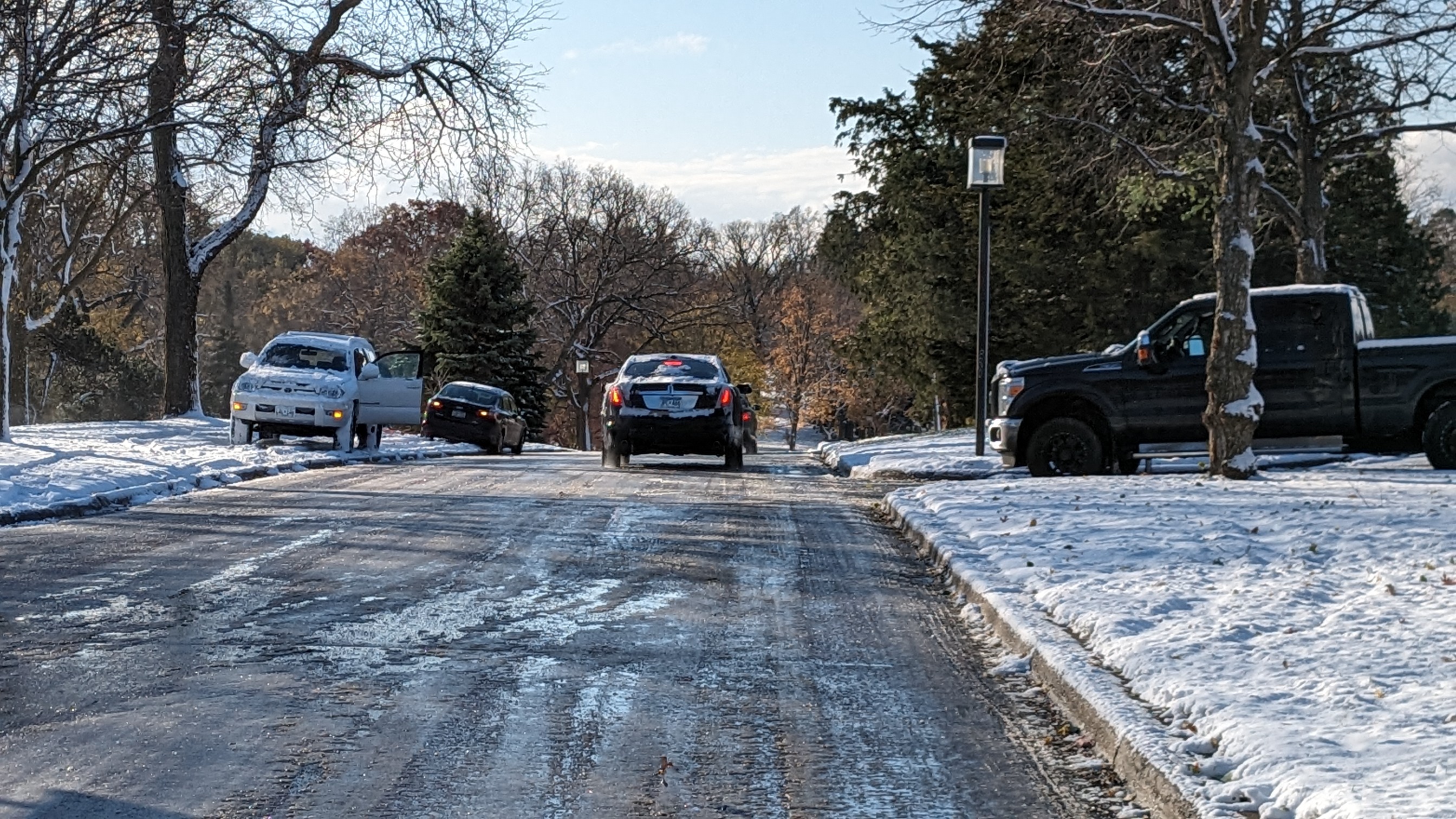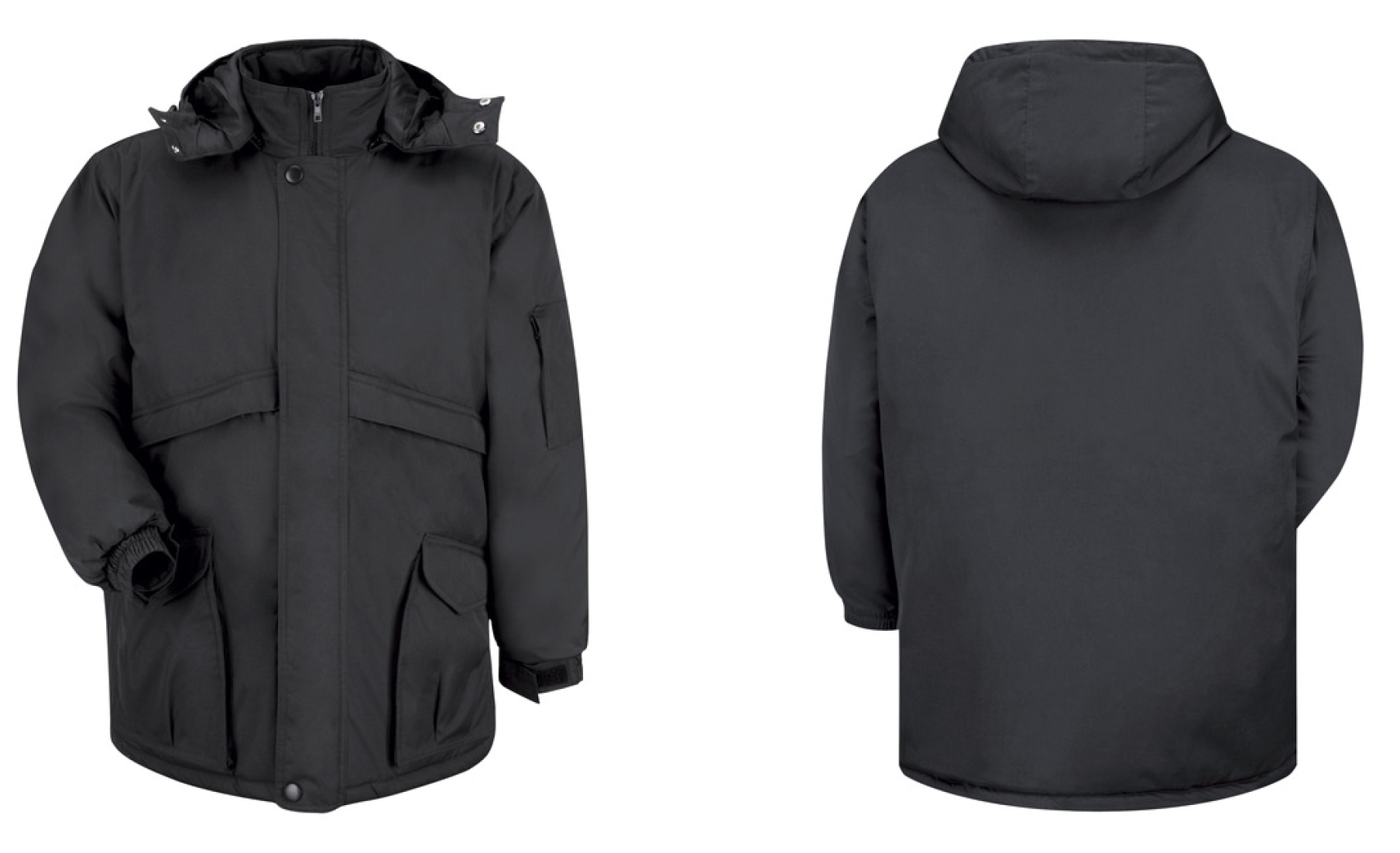Sunset Hill, at the top of Valley View Park on Theodore Wirth Parkway in Minneapolis, is a great place for sledding.
If you can get there in one piece. The hilltop lot’s steep approach slickens at the mere hint of frozen precipitation. After heavier events the parkway is basically a skating rink. Cars frequently slide sideways down the hill or get stuck on the way up, forcing drivers and cyclists onto neighborhood streets that often aren’t in much better shape.
The same scene plays out across the Minneapolis parkway system. But why are our scenic park roads so treacherous in winter? And could there be a bold solution?
Blame the Sand
The answer is simple: sand. It’s (mostly) the sand.
In Minneapolis, the Public Works department is responsible for snow and ice management on parkway roads, even though they’re owned by the Park & Recreation Board. (Last year Park Board officials described the state of the 55-mile parkway system as “devastating,” estimating that it’ll be undrivable in 15 years without drastically increased funding.)
Public Works trucks primarily use sand to treat the streets, according to city spokesperson Sarah McKenzie; any salt in the mix is there “to keep the sand from freezing.” The city does pre-treat parkway hills, curves, and other problem areas with super-salty liquid brine, though most of the system is low-salt. The treatment mix is totally different on non-parkway streets, which receive much more salt. The city more aggressively sands non-parkways “when temperatures go below zero degrees and the salt no longer is effective to provide some traction,” McKenzie says.
And that’s the problem right there: Salt and sand are the yin and yang of winter road treatments. Salt melts snow and ice (technically by lowering water’s freezing point, but no one cares) while sand improves grip on remaining slick spots. Sand has no melting power; salt does nothing for traction. Which is fine when it’s not especially frigid, because wet pavement is less slippery than snowy or icy pavement.
But salt is bad for the environment, as anyone who’s tried to grow delicate plants on oversalted boulevard strips around here knows. It compacts roadside soils, worsening drainage problems on biking and walking trails near parkway roads. It’s corrosive, which is why cars rust out faster in cold climates. (Bikes, too.) And we dump a lot of it. New estimates from the Minnesota Pollution Control Agency warn that the 445,000 tons hitting state roads each year pose considerable risks to water.
So the sandy parkway road treatment mix is probably a good thing, ecologically speaking. And if you drive a car, you can deal with it by doing stuff you should be doing anyway: slowing down, avoiding problem areas, maybe not driving on parkway roads at all if you can help it.
Trails > Parkways (Usually)
What’s more interesting than what happens on parkway roads in winter is what often happens right next to them.
High-traffic park trails and separated bikeways tend to be cleared sooner and more thoroughly than nearby roads after winter weather. (It’s a rare cold-season scenario where it’s safer to be on a bike than in a car.) And that’s true not just in Minneapolis but also across the river. Unlike on parkway roads and city streets, winter maintenance on most urban bike and pedestrian trails falls to city or county parks departments like the Minneapolis Park & Recreation Board and Ramsey County Parks & Recreation.
“Any trail that is under the purview of a parks department is likely to be cleared early and pretty well,” says Ian Buck, a teacher and Streets.mn podcaster who bikes year-round in both cities. Buck spent several winters commuting to St. Paul’s East Side along the Bruce Vento Trail, which hugs four-lane Phalen Boulevard much of the way. “I’d be biking early in the morning, middle of a snowstorm, and there’s a pickup truck clearing the path before the first plow touches Phalen,” he says.
Out west, the Minneapolis Park Board actively prioritizes commuter trails like the Midtown Greenway and the Great Northern Greenway, says Park Board spokesperson Robin Smothers. In areas with separate biking and walking trails near water bodies, the Park Board clears only the outer path to conserve resources and reduce environmental impacts. That has the additional benefit of allowing crews to focus on the trails in heavier use. “We often get emails and social media mentions in the winter thanking our crews for clearing those trails in time for the commute,” Smothers reports.
If you have a bad winter experience on a non-motorized trail around town, you can probably blame the state of Minnesota, Dan Marshall says. The avid St. Paul cyclist and occasional Racket contributor observes that state trails like the Gateway Trail and Luce Line Trail, which are maintained by the Minnesota Department of Natural Resources, are “spotty at best.” The worst offenders are trails sharing rights-of-way with state, U.S., and/or interstate highways maintained by MnDOT. These trails “are cleared sporadically if at all,” he says.
Blame MnDOT, then? Maybe. The department doesn’t actually maintain most non-motorized paths along its highways, says spokesperson Anne Meyer. It relies on cities, counties, and sometimes the DNR instead.
The good news is that few such trails cut through the Twin Cities’ core, so they’re easy enough for in-town commuters to avoid. But MnDOT partners’ lackadaisical approach to trail maintenance on major river crossings like State Highway 5 and I-35E is a big problem for the relatively few cyclists who use them in winter, Marshall says. These sections can go days without being cleared, all the while collecting plow debris from main roadways. Last winter, I-494’s “impassable” Mississippi crossing was the single worst stretch of Buck’s post-snowstorm ride out to a weekend campout at Afton State Park. “Three days after the snow ended, they still hadn’t touched it,” he says.
I-494’s non-motorized path is maintained by the city of South St. Paul, Meyer says. MnDOT crews would (probably) have cleared it within three days of a storm because the department tackles any non-motorized infrastructure for which it’s responsible soon after the main roadway is done. “I can’t speak to what materials or equipment local partners use or the areas they prioritize,” she adds.
MnDOT takes complaints from non-motorized users through its general inbox or roadside issues reporting tool, per Meyer. Even when it’s not directly responsible for the trail in question.
$88K for City Plow, Shovel Tracking?
In Minneapolis, non-motorized commuters know to check the Park Board’s near-real-time trail conditions map after snow events. It’s responsive enough that cyclists checking it before heading out the door can be reasonably sure of its accuracy. (Which is good, says Marshall, because cyclists who do encounter unexpected issues on the trail must then contend with Minneapolis’s “dismissive” 311-based complaint system; St. Paul’s Parks and Public Works departments are far more responsive to user complaints, he says.)
So why is it just for non-motorized trails? A citywide plowing status app covering city streets and parkways would cost $255,000 to set up and $45,000 per year after that, according to a city report on sidewalk snow and ice removal from earlier this year. Expanding coverage to city sidewalks bumps the setup and ongoing costs to $476,000 and $88,000, respectively. Worth considering: These are rounding errors in a $1.8 billion city budget, and well under the $595,000 cost of this winter’s sidewalk clearance pilot program.
The city might offload some of the effort on mapping apps like Google or Apple Maps, says Buck of Streets.mn, potentially saving some cash in the process. Google Maps shows real-time bus and train headways because Metro Transit publishes that data “in a format that third-party mapping apps can ingest and use,” he says.
But the city apparently has other priorities. “We continue to monitor the use of these tools in the industry but are not actively pursuing a project right now,” McKenzie says. The next step, she says, is yet another study “that builds on the 2018 study options and the 2020 Transportation Action Plan actions related to winter walking and biking.”
Questioning the Status Quo
Plowing status app or no, maybe we’re thinking about this all wrong. Maybe parkway roads are scary as hell in winter because we’re trying to fit them for a purpose they don’t need to serve. If the current half-measures aren’t adequate and we—for good reason—aren’t willing to treat them like normal city streets, maybe we should ban cars on parkways.
Minneapolis experimented with this idea early in the COVID-19 pandemic and it worked out great. Car-free parkway advocates are asking why we didn’t keep a good thing going.
“The idea of motorized parkways is well past its expiration date,” Marshall says. “Drivers almost universally far exceed the 20 mph limit and they’re never careful at trail crossings.”
Buck agrees, though if he could choose, he’d prefer a seasonal ban during the cold months. Car-free parkway roads could double as groomed Nordic ski routes, vastly increasing urban ski trail mileage and connectivity while still allowing bikes to use the same rights of way. “It would be cool to be able to ski to a friend’s house [on the parkway],” he says.
Jeremy Winter, a south Minneapolis resident who goes out of his way to avoid treacherous in-street bike boulevards and non-separated bike lanes in winter, would rather focus on one peril at a time. “You have to choose between the danger of sharing the road with cars or the danger of falling over due to poorly maintained roads,” he says.
With the parkway closures’ success memory-holed along with most other pandemic-era lessons, the prospect of even a seasonal car ban feels remote. Which brings us back to where we began: gunning it furiously up that icy incline as we slide slowly, slowly backwards into the long line of cars behind us, eyes fixed on the one remaining parking spot in the sledding hill lot.







